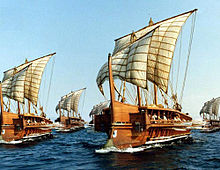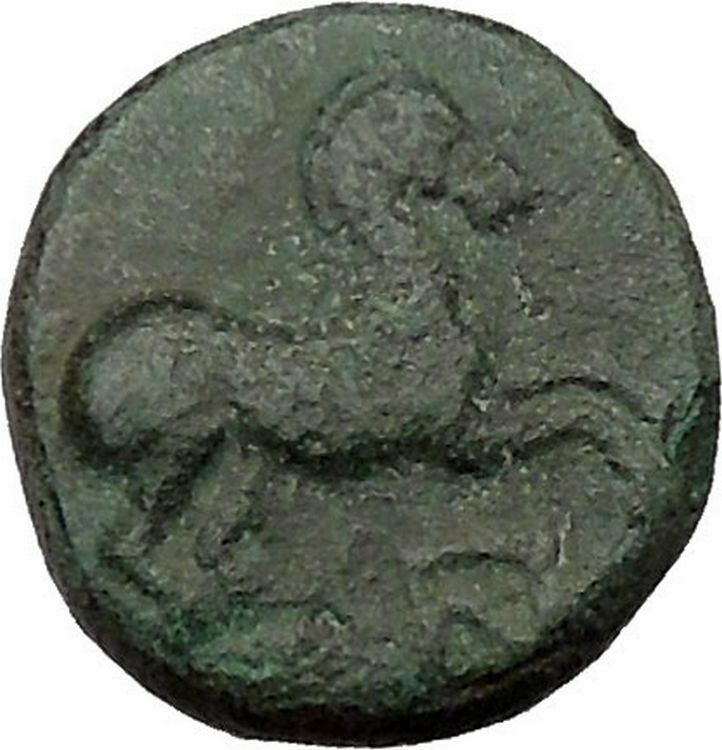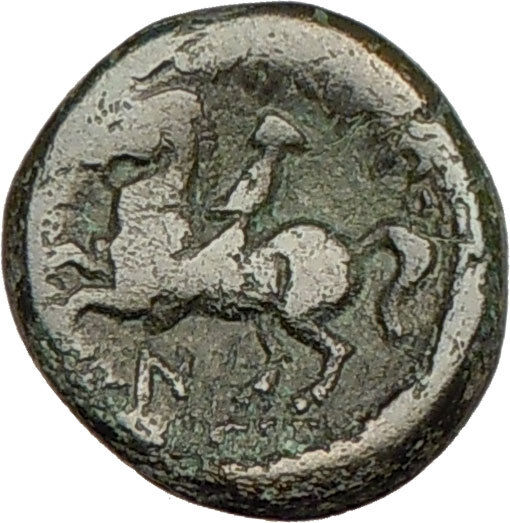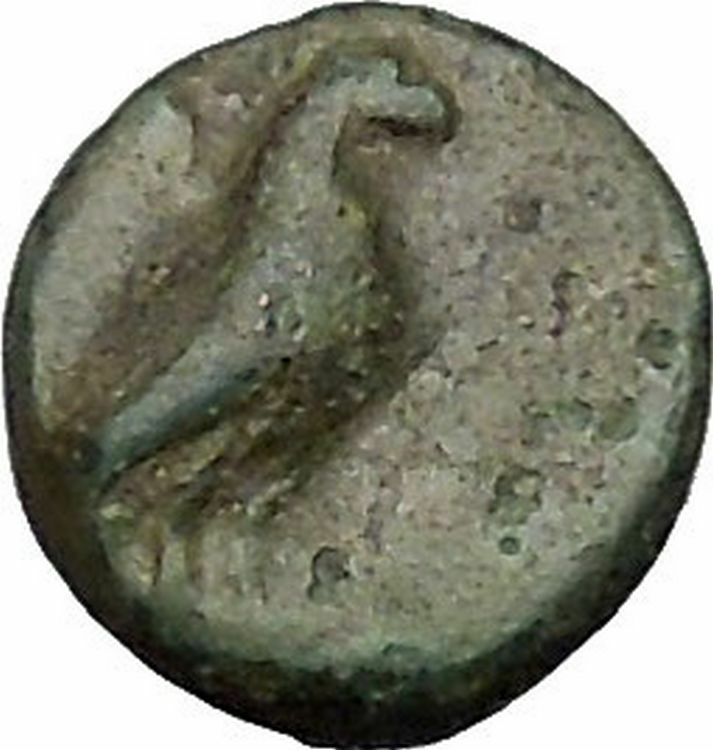|
Greek city of
Sidon in
Phoenicia
Bronze 21mm (9.41 grams) Struck circa 109-100 B.C.
Reference: HGC 10, 281; Rouvier 1902, nos. 1330-1334
Veiled and turreted bust of Tyche right; monogram to left.
ΣΙΔΩΝΙΩΝ, Galley left; Phoenician inscription
(belonging to the Sidonians) below; civic era date above.
About 20 miles north of Tyre, Sidon was a city of great
antiquity and in early times the chief seat of the maritime power of the
Phoenicians. Commercially it was important as the center of purple-dyeing
industry and for the manufacture of glass – the art of glass-blowing having been
discovered at Sidon in the 1st Century B.C.
You are bidding on the exact item pictured,
provided with a Certificate of Authenticity and Lifetime Guarantee of
Authenticity.
Tyche (Greek for luck; the Roman equivalent was
Fortuna
) was the presiding
tutelary deity
that governed the fortune and
prosperity of a city, its destiny. Increasingly during the Hellenistic period,
cities had their own specific iconic version of Tyche, wearing a
mural crown
(a crown like the walls of the
city).

The
Greek historian Polybius
believed that when no cause can be
discovered to events such as floods, droughts, frosts or even in politics, then
the cause of these events may be fairly attributed to Tyche.
Stylianos Spyridakis concisely expressed Tyche’s appeal in a
Hellenistic world of arbitrary violence and unmeaning reverses: “In the
turbulent years of the
Epigoni of Alexander
, an awareness of the
instability of human affairs led people to believe that Tyche, the blind
mistress of Fortune, governed mankind with an inconstancy which explained the
vicissitudes of the time.”
In literature, she might be given various genealogies, as a daughter of
Hermes
and
Aphrodite
, or considered as one of the
Oceanids
, daughters of
Oceanus
and
Tethys
, or of
Zeus. She was connected with
Nemesis
and
Agathos Daimon
(“good spirit”).
She was uniquely venerated at
Itanos
in Crete, as Tyche Protogeneia,
linked with the Athenian
Protogeneia
(“firstborn”), daughter of
Erechtheus
, whose self-sacrifice saved the
city.
She had temples at
Caesarea Maritima
,
Antioch
,
Alexandria
and
Constantinople
. In
Alexandria
the Tychaeon, the temple of
Tyche, was described by
Libanius
as one of the most magnificent of the
entire Hellenistic world.
Tyche appears on many
coins
of the Hellenistic period in the three
centuries before the Christian era, especially from cities in the Aegean.
Unpredictable turns of fortune drive the complicated plotlines of
Hellenistic romances
, such as
Leucippe and Clitophon
or
Daphnis and Chloe
. She experienced a
resurgence in another era of uneasy change, the final days of publicly
sanctioned
Paganism
, between the late-fourth-century
emperors
Julian
and
Theodosius I
who definitively closed the
temples. The effectiveness of her capricious power even achieved respectability
in philosophical circles during that generation, though among poets it was a
commonplace to revile her for a fickle harlot.
In medieval art
, she was depicted as carrying a
cornucopia
, an
emblematic
ship’s rudder, and the
wheel of fortune
, or she may stand on the
wheel, presiding over the entire circle of fate.
The constellation of
Virgo
is sometimes identified as the heavenly
figure of Tyche, as well as other goddesses such as
Demeter
and
Astraea
.

A
galley is a type
of ship
propelled by
rowers
that originated in the eastern
Mediterranean Sea
and was used for
warfare
,
trade
and
piracy
from the first millennium BC. Galleys
dominated
naval warfare
in the Mediterranean from the 8th
century BC until development of advanced sailing warships in the 17th century.
Galleys fought in the wars of
Assyria
, ancient
Phoenicia
,
Greece
,
Carthage
and
Rome
until the 4th century AD. After the fall
of the
Western Roman Empire
galleys formed the
mainstay of the
Byzantine navy
and other navies of successors
of the Roman Empire, as well as new
Muslim
navies. Medieval Mediterranean states,
notably the Italian maritime republics, including
Venice
,
Pisa
,
Genoa
and the
Ottoman Empire
relied on them as the primary
warships of their fleets until the 17th century, when they were gradually
replaced by sailing warships. Galleys continued to be applied in minor roles in
the Mediterranean and the
Baltic Sea
even after the introduction of
steam propelled
ships in the early 19th
century.
The galley engagements at
Actium
and
Lepanto
are among the greatest
naval battles
in history.
Sidon has been inhabited since 4000 BC and perhaps as early as
Neolithic times (6000 – 4000 BC). It was one of the most important
Phoenician
cities, and may have been the
oldest. From here, and other ports, a great Mediterranean commercial empire was
founded. Homer
praised the skill of its craftsmen in
producing glass and purple dyes. It was also from here that a colonizing party
went to found the city of
Tyre
. Tyre also grew into a great city, and in
subsequent years there was competition between the two, each claiming to be the
metropolis (‘Mother City’) of Phoenicia. Glass manufacturing, Sidon’s most
important enterprise in the Phoenician era, was conducted on a vast scale, and
the production of purple dye was almost as important. The small shell of the
Murex trunculus was broken in order to extract the pigment that was so rare it
became the mark of royalty.
In AD 1855, the sarcophagus of King
Eshmun’azar
II was discovered. From a
Phoenician inscription on its lid, it appears that he was a “king of the
Sidonians,” probably in the 5th century BC, and that his mother was a priestess
of
‘Ashtart
, “the goddess of the Sidonians.” In
this inscription the gods
Eshmun
and
Ba‘al
Sidon ‘Lord of Sidon’ (who may or may not
be the same) are mentioned as chief gods of the Sidonians. ‘Ashtart is entitled
‘Ashtart-Shem-Ba‘al ‘‘Ashtart the name of the Lord’, a title also found
in an
Ugaritic
text.
In the years before
Jesus
, Sidon had many conquerors:
Assyrians
,
Babylonians
,
Egyptians
,
Greeks
, and finally
Romans
.
Herod the Great
visited Sidon. Both Jesus and
Saint Paul
are said to have visited it too (see
Biblical Sidon
below). The city was
eventually conquered by the Arabs and then by the Ottoman Turks.
Like other Phoenician city-states, Sidon suffered from a succession of
conquerors. At the end of the
Persian
era in 351 BC, it was invaded by the
emperor
Artaxerxes III
and then by
Alexander the Great
in 333 BC when the
Hellenistic
era of Sidon began. Under the
successors of Alexander, it enjoyed relative freedom and organized games and
competitions in which the greatest athletes of the region participated. In the
Necropolis of Sidon, important finds such as the Alexander Sarcophagus, the
Lycian tomb and the Sarcophagus of the Crying Women were discovered, which are
now on display at the
Istanbul Archaeology Museum
in
Istanbul
.
When Sidon fell under Roman domination, it continued to mint its own silver
coins. The Romans also built a theater and other major monuments in the city. In
the reign of Elagabalus a Roman colonia was established there, and it was given
the name of Colonia Aurelia Pia Sidon. During the
Byzantine
period, when the great earthquake of
AD 551 destroyed most of the cities of Phoenicia,
Beirut
‘s School of Law took refuge in Sidon.
The town continued quietly for the next century, until it was conquered by the
Arabs
in AD 636.

Sidon with a view of the Mediterranean coast
On December 4, 1110 Sidon was
sacked
in the
First Crusade
by King Baldwin of Jerusalem and
King Sigurd of Norway. It then became the centre of the
Lordship of Sidon
, an important seigneury in
the
Kingdom of Jerusalem
. During the Crusades it
was sacked several times: it was finally destroyed by the
Saracens
in 1249. In 1260 it was again
destroyed by the Mongols
. The remains of the original walls are
still visible.
After Sidon came under
Ottoman Turkish
rule in the seventeenth
century, it regained a great deal of its earlier commercial importance. After
World War I
it became part of the French
Mandate
of
Lebanon
. During
World War II
the city, together with the rest
of Lebanon, was captured by
British
forces fighting against the
Vichy
French
, and following the war it became a major
city of independent
Lebanon
.
Following the
Palestinian exodus
in 1948, a considerable
number of
Palestinian
refugees arrived in Sidon, as in
other Lebanese cities, and were settled at the large refugee camps of
Ein el-Hilweh
and
Mieh Mieh
. At first these consisted of enormous
rows of tents, but gradually houses were constructed. The refugee camps
constituted de-facto neighborhoods of Sidon, but had a separate legal and
political status which made them into a kind of enclaves. At the same time, the
remaining Jews of the city fled, and the Jewish cemetery fell into disrepair,
threatened by coastal erosion.
|











